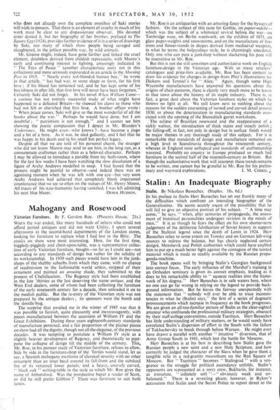Mahogany and Rosewood
yictorian Furniture. By F. Gordon Roe. (Phoenix House. 21s.)
WHEN the war ended, like many hundreds of others who could not afford period antiques and did not want Utility, I spent several afternoons in the second-hand departments of the London stores, looking for furniture to replace what I had lost in the Blitz. The stocks on show were most interesting. Here, for the first time, higgledy-piggledy and chest-upon-table, was a representative collec- tion of early Victorian furniture, bought—so far as I could, see—not according to any standards of design but rather for the solidity of its workmanship. In 1939 such pieces would have lain in the junk- shops of the shabby suburbs from which they came, with no chance of readmission to the fashionable world unless, stripped of their ornament and painted an amusing shade, they submitted to the process of Chelsification. The Regency style had been established in the late 'thirties as the last deserving the name antique, and the West End dealers, some of whom had been collecting the furniture of the early nineteenth century for a decade, then unloaded it on to the modish public. But the re-entry of the Victorian style was not prepared by the antique dealers ; its sponsors were the bomb and the doodle-bug.
The surprise that awaited me in the winter of 1945 was that it was possible to furnish, quite pleasantly and inextravagantly, with pieces manufactured between the accession of William IV and the Great Exhibition. During these years eighteenth-century standards of manufacture persisted, and a fair proportion of the plainer pieces on show had all the dignity, though not all the elegance, of the previous decades. It was tempting to postulate a William IV style as a slightly heavier development of Regency, and theoretically to post- pone the collapse of design till the middle of the century. This, Mr. Roe, in his pioneer study of Victorian furniture, refuses to allow. Side by side in the furniture-shop of the 'forties would stand, let us say, a Spanish mahogany escritoire of classical severity with no other ornament than an inset bead around its fall-front and the subdued fire of its veneered lower panels,- and a heavy, coarsely carved, " black oak " writing-table in the style to which Mr. Roe gives the name of Abbotsford. Was the prospective buyer a reader of Scott, or did he still prefer Gibbon ? There was furniture to suit both tastes.
Mr. Roe is an antiquarian with an amusing fancy for the byways of fashion. On the subject of this taste for Gothic, on papier-mâché-- which was the subject of a whimsical revival before. the war—on Tonbridge ware, on Berlin woolwork, on the exhibits of 1851, on glass paper-weights and snowstorms, and on the manufacture of fire- irons and flower-stands in shapes derived from mediaeval weapons, in what he terms the bulgeydingo style, he is charmingly anecdotal. Only one who can pass a junkshop without slackening his pace will be insensitive to Mr. Roe.
But this is not the still unwritten and authoritative work on English furniture-design in the Victorian age. With so many retailers' catalogues and price-lists available, Mr. Roe has been content to draw his evidence for changes in design from Phiz's illustrations for Dickens and Tenniel's for " Alice." Again, though some High Wycombe manufacturers have answered his questions about the origins of chair-patterns, there is clearly very much more to be learnt in that town about the history of its staple industry. There is, in fact, a great deal about the Victorian furniture styles on which he thrbws no light at all. We still know next to nothing about the reasons for the sudden coarsening of turned and carved detail around 1830, or about the deterioration in manufacturing standards asso- ciated with the opening of the Shoreditch garret workshops.
The eclipse of Brazilian rosewood and the reappearance of a sickly walnut, the introduction of thick stains and treacly polish ; the falling-off, in fact, not only in design but in surface finish would be major themes in any thorough study of this subject. For it is remarkable that standards of design and manufacture remained on a high level in Scandinavia throughout the nineteenth century, whereas in England taste collapsed and standards of craftsmanship wavered. Probably no country in Europe produced so much bad furniture in the second half of the nineteeth-century as Britain. But though the authoritative work that will interpret these trends remains to be written, one cannot but be grateful to Mr. Roe for his prelim-










































 Previous page
Previous page